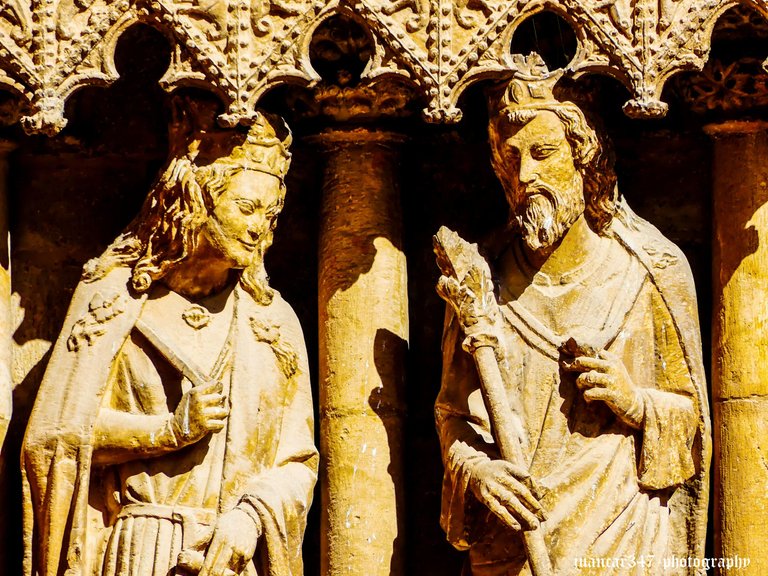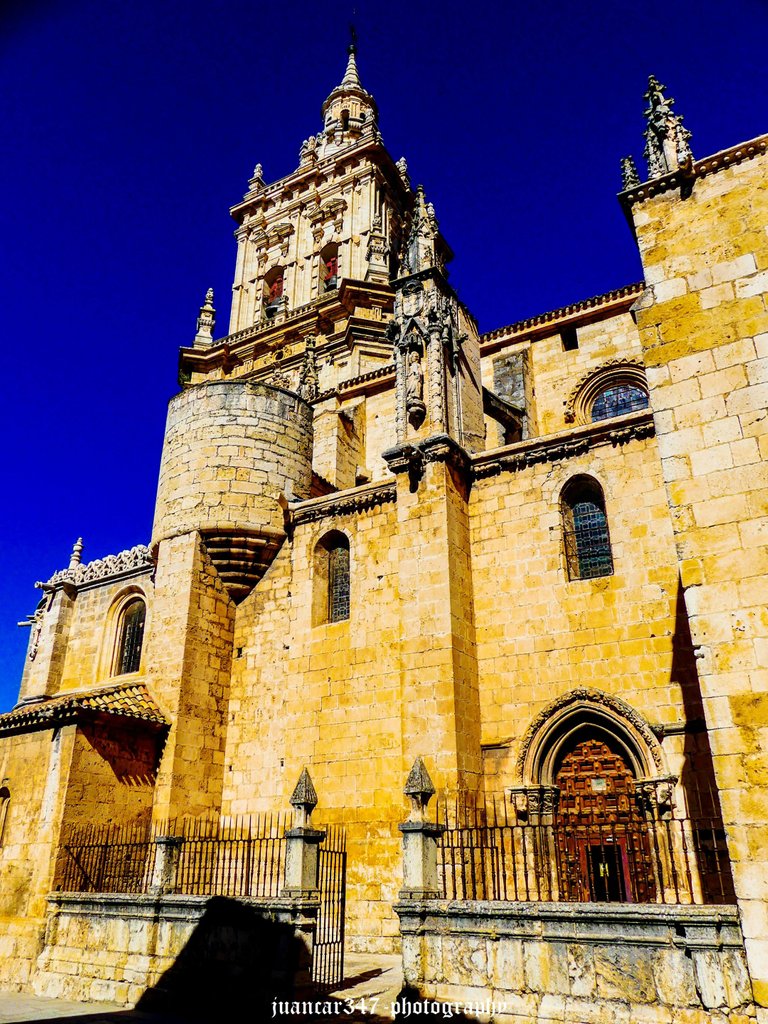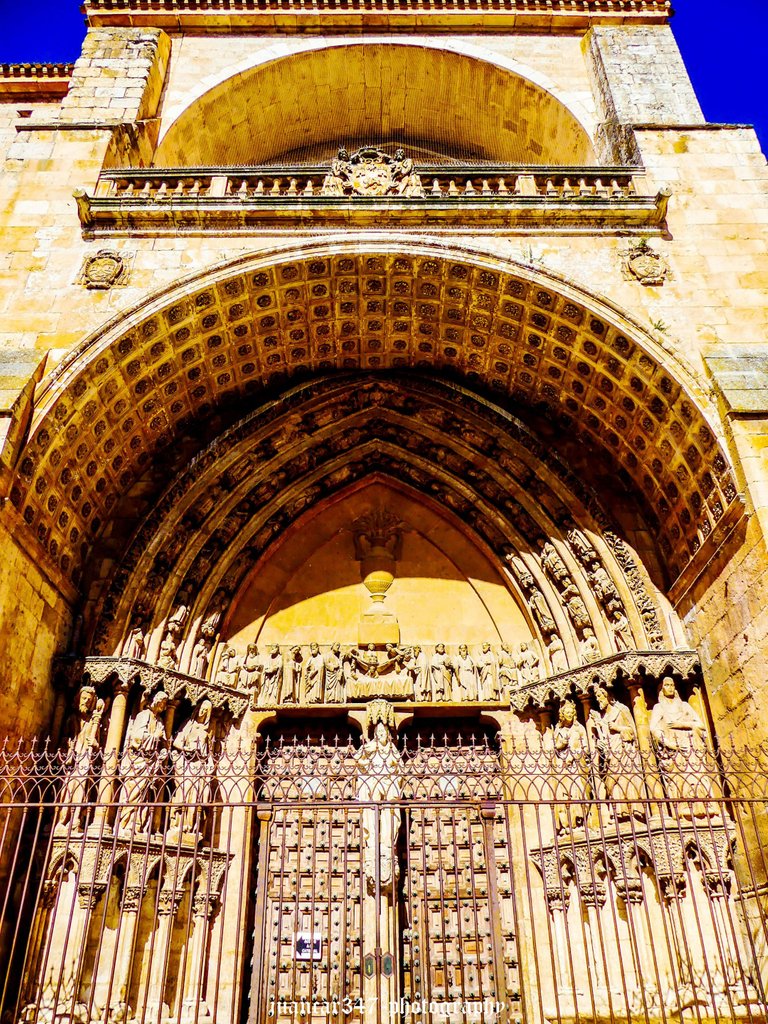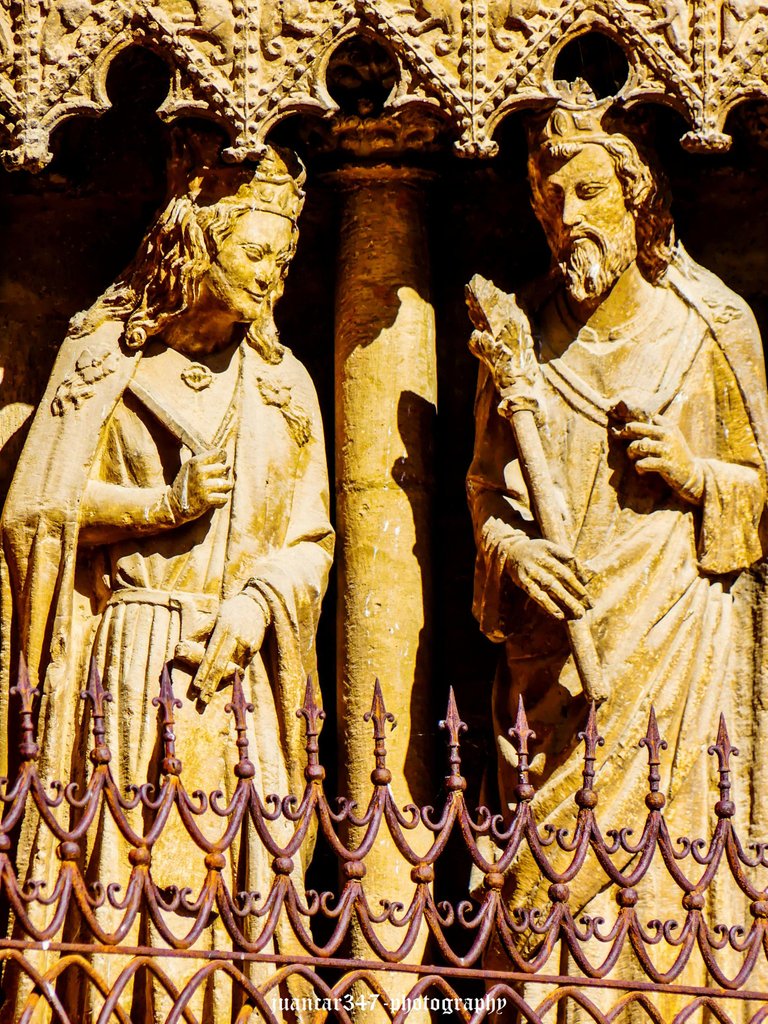[ENG-SPN] Dialogues between Solomon and the Queen of Sheba / Diálogos entre Salomón y la reina de Saba

Within that city of contrasts and notable mysteries, which is the Burgo de Osma, its cathedral, built next to and in memory of the blessed founder, Pedro de Osma -whose polychrome tomb is already an authentic work of art- Not only does it respond to an architectural attraction, which, started in a purely Romanesque period, was adapted to later styles, attending to the fashions, tastes and desires of each era, but also preserves, in view of all those who stop long enough to contemplate it, numerous enigmas, not exempt, however, from an emotional romanticism. One of them -the one that inevitably invites speculation and even, going further, to reverie, due to its notable mystical and, at the same time, poetic charge- is found in the sculptural imagery that affects its singular main portal and is based on two unusual characters, such as, without a doubt, the popular King Solomon and the no less popular figure of Belkis, better known, historically, as the mysterious Queen of Sheba and to whom the famous phrase is attributed, which, curiously, appears in the practically all of the Black Madonnas of Romanesque art: 'Nigra sum sed formosa'; that is, 'I'm black, but beautiful'.

Leaving aside the extraordinary quality of the sculptures and locating them in front of those other arcosolios in which the severe figure of Moses also induces one to speculate with those curls in the hair, similar to small protuberances or false horns, which, apparently, his appearance was transfigured during his mystical and unknowable encounter with Yahveh on the top of the mythical Mount Sinai, the attitude of confidential dialogue maintained by these two characters does not seem to be accidental at all -and here the intention of the anonymous artist is derived- completely oblivious to the imagery that affects the rest of the designs, mostly apostles, like Peter and Paul. On the contrary, Belkis and Solomon seem to have been represented here as the perfect lovers -Jung's anima and animus or the Yin and Yang, oriental- although the detail of the apparent complicity that configures the faces of both lovers, where the enigmatic smile of Belkis, the Queen of Sheba, stands out, without a doubt, a forerunner, within this Gothic style, of that other one that Leonardo immortalized in his famous Mona Lisa and that has given rise to so many speculations throughout history. The truth is that, contemplating them, it is impossible not to remember one of the poetic works, with the most sensual charge of the ancient world: the Song of Songs.

Dentro de esa ciudad de contrastes y notables misterios, que es el Burgo de Osma, su catedral, edificada a la vera y a la memoria del beato fundador, Pedro de Osma -cuyo sepulcro policromado es ya de por sí, una auténtica obra de Arte- no sólo responde a un atractivo arquitectónico, que, iniciado en un periodo netamente románico, fue amoldándose a posteriores estilos, atendiendo a las modas, gustos y deseos de cada época, sino, que, además, conserva, a la vista de todo aquel que se detenga el tiempo suficiente a contemplarla, numerosos enigmas, no exentos, sin embargo, de un emotivo romanticismo. Uno de ellos -aquel que invita irremediablemente a la especulación e incluso, yendo más allá, a la ensoñación, por su notable carga mística y a la vez, poética- lo encontramos en la imaginería escultórica que afecta a su singular portada principal y se basa en dos personajes inusuales, como son, sin duda, el mediático rey Salomón y la no menos mediática figura de Belkis, más conocida, históricamente, como la misteriosa reina de Saba y a la que se atribuye la famosa frase, que, curiosamente, figura en la práctica totalidad de las Vírgenes Negras del arte románico: ‘Nigra sum sed formosa’; es decir, ‘Soy negra, pero hermosa’.

Dejando aparte, la extraordinaria calidad de las esculturas y localizándolas enfrente de aquellos otros arcosolios en los que la severa figura de Moisés induce, también, a especular con esos bucles en el cabello, semejantes a pequeñas protuberancias o falsos cuernos, que, al parecer, le transfiguraron el aspecto durante su místico e incognoscible encuentro con Yahveh en la cima del mítico monte Sinaí, no parece ser casual, en absoluto -y aquí se deriva la intencionalidad del anónimo artista- la actitud de confidencial diálogo, que mantienen estos dos personajes, ajenos, por completo, a la imaginería que afecta al resto de diseños, en su mayoría, apóstoles, como Pedro y Pablo. Por el contrario, Belkis y Salomón, parecen haber sido aquí representados como los amantes perfectos -el ánima y el animus de Jung o el Yin y el Yang, oriental- si bien, no deja de ser singular el detalle de la aparente complicidad que configura los rostros de ambos amantes, donde destaca, sin lugar a dudas, la enigmática sonrisa de Belkis, la reina de Saba, precursora, dentro de este estilo gótico, de aquella otra que inmortalizó Leonardo en su famosa Mona Lisa y que ha dado lugar a tantas especulaciones a lo largo de la Historia. Lo cierto, es que, contemplándolos, es imposible no recordar una de las obras poéticas, con más carga sensual del mundo antiguo: el Cantar de los Cantares.

NOTICE: Both the text and the photographs that accompany it are my exclusive intellectual property and, therefore, are subject to my Copyright.
AVISO: Tanto el texto, como las fotografías que lo acompañan, son de mi exclusiva propiedad intelectual y por lo tanto, están sujetos a mis Derechos de Autor.
